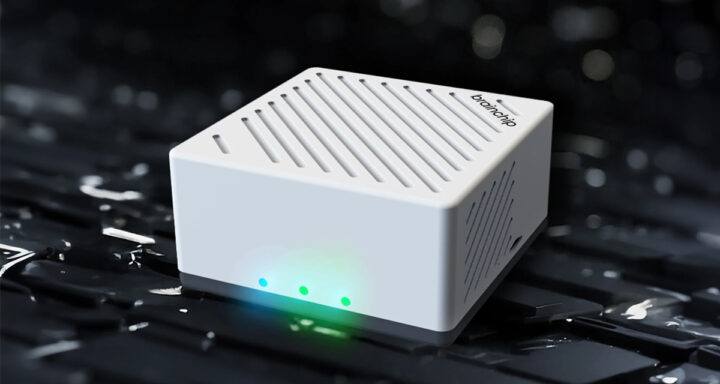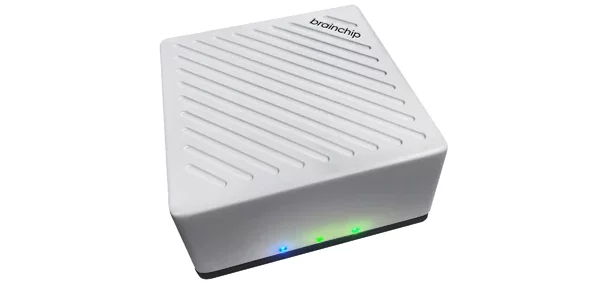BrainChip has recently opened preorders for their Akida Edge AI Box, built in partnership with VVDN Technologies. This box features an NXP i.MX 8M Plus SoC and two Akida AKD1000 neuromorphic processors for low-latency, high-throughput AI processing at the edge.
The system features USB 3.0 and micro-USB ports, HDMI, 4GB LPDDR4 memory, 32GB eMMC with up to 1TB micro-SDXC expansion, dual-band Wi-Fi, and two gigabit Ethernet ports for external camera connections, all within a compact, passively-cooled chassis, powered by 12V DC.
BrainChip Akida Edge AI Box Specifications:
- Host CPU – NXP i.MX 8M Plus Quad SOC with 64-bit Arm Cortex-A53 processor running at up to 1.8GHz
- AI/ML Accelerator – Dual Brainchip AKD1000 (Akida Chip) over PCIe for efficient AI processing
- Memory – 4GB LPDDR4
- Storage
- 32GB eMMC flash
- MicroSD card slot for additional storage options
- Display Output – HDMI output supporting up to 3840 x 2160p30 resolutions with a pixel clock up to 297MHz
- Network Connectivity
- Wi-Fi: 802.11 ac/b/g/n/ac (2.4GHz/5GHz) for wireless connectivity
- Ethernet – Two ports with 10/100/1000Mbps, also supports external camera interfaces
- Video Processing Capabilities
- Max Encode – 1x 1080p60 (H.265 & H.264) / 2x 1080p30 (H.265 & H.264) / 4x 720p30 (H.265 & H.264)
- Max Decode – 1x 1080p60 (H.265 & H.264) / 2x 1080p30 (H.265 & H.264) / 4x 720p30 (H.265 & H.264)
- USB
- USB 3.0 Type-A port for high-speed data transfer
- USB 2.0 Micro-B port for flashing and debugging
- Indicators and Buttons
- Power/Reset button
- 2x RGB LED for status indication
- Power ON/OFF indication LED (Green)
- Power – 12VDC input using an external AC-DC adapter
- Environmental Conditions
- Operating temperature – 0°C to 50°C
- Operating humidity – 5% to 95% non-condensing
- Dimensions – 110 x 110 x 56mm (L x W x H)
- Operating System – Linux Embedded OS Version 6.1
The AI Box includes a GPU delivering 6 GFLOPS of compute power and uses a dual-chip PCIe AKD1000 neuromorphic processor. However, it does not support temporal event-based neural nets (TENNs) or vision transformer (ViT) features.
In 2022, Intel introduced its Neuromorphic AI accelerator, Loihi 2, and we also saw Raspberry Pi-based development kits with BrainChip AKD1000 SoC. Both technologies rely on spiking neural networks (SNN) to achieve high-performance, real-time inference with significantly lower power consumption compared to traditional AI chips that use CNN (convolutional neural network) technology.
On the software side of things, BrainChip is working on a Linux 6.1-based operating system and a collection of ready-to-use edge AI applications to showcase the capabilities of its Akida technology. The final details of these applications are still being worked out in collaboration with VVDN. Though they specifically did not talk about the software side of things some examples on BrainChip Akida Chip can be found on their GitHub account.
You can pre-order the Akida Edge AI Box from BrainChip’s online store for $799. It’s set to ship around the middle of 2024. Additional details about the product can also be found in the press release.
Debashis Das is a technical content writer and embedded engineer with over five years of experience in the industry. With expertise in Embedded C, PCB Design, and SEO optimization, he effectively blends difficult technical topics with clear communication
Support CNX Software! Donate via cryptocurrencies, become a Patron on Patreon, or purchase goods on Amazon or Aliexpress






